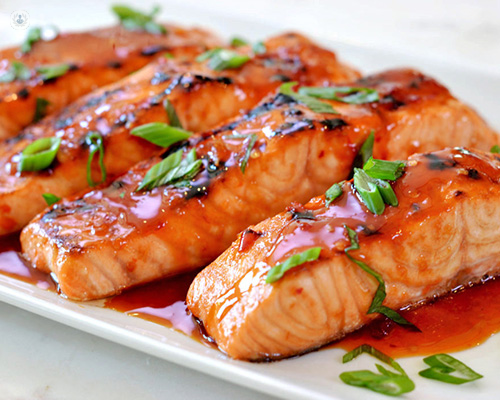Acne and diet: what foods can help in the treatment of acne?
Written by:In this informative article, we delve in to the topic of acne and diet, including the foods which can affect our skin, and various factors which can commonly cause acne.

The influence of diet on acne
The first thing to know about acne is that it is an inflammatory condition. Its most significant features are:
- Increased keratinisation of the hair follicles, causing the follicle to clog
- Increased sebum (oily, waxy matter) formation
- Microbial colonisation of the pilosebaceous unit (the hair shaft, the hair follicle, the sebaceous gland, and the erector pili muscle)
- Inflammation
Other factors, such as heredity and stress, can also aggravate acne.
In scientific terms, the initial element affecting acne starts with abnormal keratinisation. In healthy skin, keratinisation means skin cells maturing and coming to the skin's surface - in those with acne, this process is abnormal, which creates something called the microcomedone, which does not allow excess sebum or dead skin cells to exit the pore.
In puberty especially, abdrogens stimulate sebum production. These elements combine in the pilosebaceous unit to create an environment favourable to colonisation by propionibacterium acnes, which finally initiate and maintain the inflammatory response.
What food influences acne?
Two hormones are involved in stimulating an increase in keratinisation, i.e. the clogging of the hair follicle. These hormones are insulin and growth hormone (somatotropin).
Let's focus on insulin. An increase in insulin stimulates proliferation and decreases cellular self-destruction (apoptosis). Vice versa, a decrease in insulin decreases keratinisation, and therefore, reduces pilosebaceous follicle clogging. The more we eat carbohydrates with a high glycaemic load – i.e., foods with the ability to increase insulin quickly - the more stimulated the process of keratinisation. That is, carbohydrates of high glycaemic load / high levels of insulin influence the appearance and maintenance of acne.
The formation of sebum (stimulated by the action of androgens) if excessive also favours the occurrence of acne. When blood insulin increases, androgen levels increase. So diets rich in fibre increase the quantity of circulating androgens and, consequently, acne.
Foods rich in omega 3 and omega 6
The bacteria involved in the pathogenesis of acne provoke a number of inflammatory reactions that can be controlled or modified with food. One of the most relevant factors in the influence of diet on inflammation is the relationship between omega 6 and omega 3 fatty acids.
Omega-6 acids have pro-inflammatory properties while omega-3s are more anti-inflammatory. Therefore, a favourable diet to treat acne should have a high intake of omega-3 foods, like fish.
It is significant that humans evolved from a diet where the omega-6 / omega-3 ratio was approximately 1:1, to where, in western diets, it is now 15/1, due to the predominance of omega-6 in vegetable oils and processed foods.
However, it can be concluded that diet-induced acne inflammation is due to:
- High saturated and trans-fat consumption
- Increased consumption of sugars and refined products (rice, pasta, bread)
- Decreased consumption of natural antioxidants (fruits and vegetables)
- A sedentary lifestyle
- Over-consumption of omega-6 acids (sunflower oil, corn, directly or through industrialised products), without adequate compensation through foods rich in Omega 3 (fish, flax seeds)


